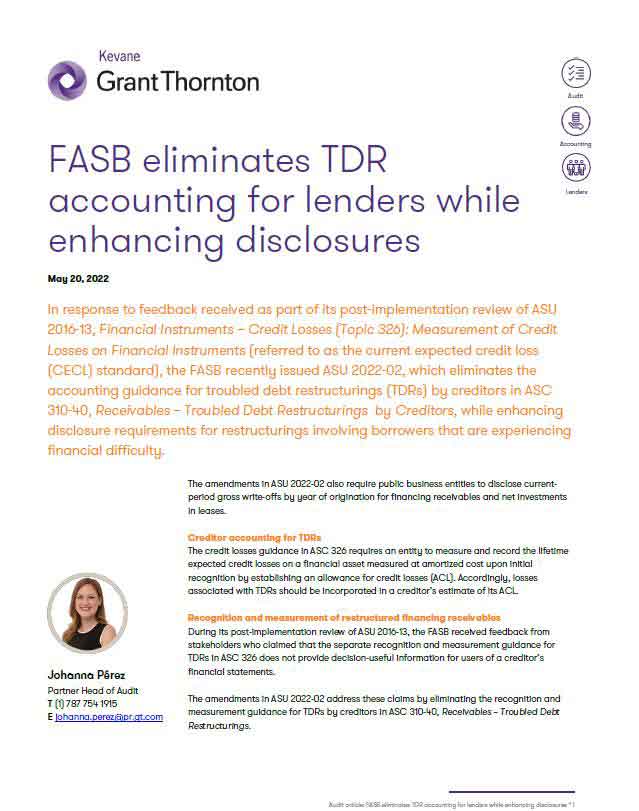The amendments in ASU 2022-02 also require public business entities to disclose current-period gross write-offs by year of origination for financing receivables and net investments in leases.
Creditor accounting for TDRs
The credit losses guidance in ASC 326 requires an entity to measure and record the lifetime expected credit losses on a financial asset measured at amortized cost upon initial recognition by establishing an allowance for credit losses (ACL). Accordingly, losses associated with TDRs should be incorporated in a creditor’s estimate of its ACL.
Recognition and measurement of restructured financing receivables
During its post-implementation review of ASU 2016-13, the FASB received feedback from stakeholders who claimed that the separate recognition and measurement guidance for TDRs in ASC 326 does not provide decision-useful information for users of a creditor’s financial statements.
The amendments in ASU 2022-02 address these claims by eliminating the recognition and measurement guidance for TDRs by creditors in ASC 310-40, Receivables – Troubled Debt Restructurings.
Modification versus new financing receivable
Under existing guidance, restructurings of financing receivables that are determined to be TDRs are not subject to the guidance in ASC 310-20-35-9 through 35-11 for determining whether the restructuring is “more than minor” and is, therefore, a new financing receivable. Under the amendments, however, all restructurings of financing receivables should be evaluated under that guidance to determine whether a restructuring is accounted for as a new financing receivable or as a modification of an existing financing receivable that would affect the existing financing receivable’s effective interest rate, including the accounting for unamortized net fees and costs. That being said, it is unlikely that restructurings of financing receivables classified as TDRs under ASC 310-40 would result in the recognition of a new financing receivable under the guidance in ASC 310-20-35-9 through 35-11 because, to be a new financing receivable, the terms of the restructured financing receivable must be at least as favorable to the creditor as the terms for comparable financing receivables are to other customers with similar collection risks who are not restructuring a financing receivable. In other words, a restructuring that contains a concession when compared to market terms does not constitute a new financing receivable. Therefore, most restructurings of financing receivables by creditors that would have been classified as TDRs under ASC 310-40 will now be accounted for as modifications under ASC 310-20.
Estimating credit losses
In June 2017, the FASB’s Transition Resource Group for Credit Losses generally agreed that all effects of reasonably anticipated TDRs should be captured by a creditor’s estimate of its ACL, including the effect of interest rate concessions. In practice, this has resulted in many creditors applying a discounted cash flow approach to estimate expected credit losses on reasonably anticipated TDRs. However, the amendments in ASU 2022-02 eliminate the TDR designation for creditors, allowing entities to apply a variety of methods to estimating credit losses on restructured financing receivables that would be considered TDRs under ASC 310-40.
Entities that continue to utilize a discounted cash flow approach to estimating the ACL should use the post-restructuring effective interest rate as the discount rate for restructured financing receivables that are accounted for as modifications.
Disclosure of restructured financing receivables
The amendments in ASU 2022-02 enhance existing disclosure requirements and introduce new requirements related to restructurings of financing receivables whose borrowers are experiencing financial difficulty. The objective of the enhanced disclosure requirements is to provide financial statement users with information about the type and magnitude of restructuring, the financial effects of the restructuring, and the degree of success of the restructuring in mitigating potential credit losses. In addition, the guidance requires entities to consider providing information that helps financial statement users to understand significant changes in either the type or magnitude of restructurings, including those restructurings that were caused by a major credit event, for example, even if the restructurings would not otherwise require disclosures in ASC 310.
Under the amendments, for each period a statement of income is presented, certain disclosures are required for restructurings of financing receivables whose borrowers are experiencing financial difficulty in the form of principal forgiveness, interest rate concessions, other-than-insignificant payment delays, or term extensions (covenant waivers and modification of contingent acceleration clauses are not considered term extensions). The required disclosures include:
- by class of financing receivable, qualitative and quantitative information about
- the types of restructurings utilized by an entity, including the total period-end amortized cost basis and the percentage of the restructured receivables relative to the total period-end amortized cost basis of receivables in the class of financing receivable
- the financial effect of the restructuring by type of restructuring, which should provide information about the changes to the contractual terms as a result of the restructuring, including the incremental effect of principal forgiveness on the amortized cost basis of the restructured receivables or the weighted-average reduction in interest rates (versus a range) for interest rate concessions
- receivable performance in the 12 months following a restructuring of a receivable
- by portfolio segment, qualitative information about how those restructurings and the debtor’s subsequent performance are factored into determining the ACL
Additionally, for each period a statement of income is presented, a creditor should disclose information about financing receivables with defaulted payment during the period that were restructured in the form of principal forgiveness, interest rate concessions, other-than-insignificant payment delays, or term extensions within the previous 12 months preceding the payment default if the borrower was experiencing financial difficulties at the time of restructuring. The required disclosures include:
- by class of financing receivable, qualitative and quantitative information about those defaulted financing receivables, including
- the type of contractual change that the restructuring provided
- the amount of financing receivables that defaulted, including the period end amortized cost basis
- by portfolio segment, qualitative information about how those defaults are factored into determining the ACL
Example 3 in ASC 310-10-55-12A illustrates the enhanced disclosures required by ASC 310-10-50-42 through 50-44 for financing receivables whose borrowers are experiencing financial difficulty.
The enhanced disclosure guidance does not apply to the following financing receivables:
- receivables measured at fair value, with changes in fair value reported in earnings
- receivables measured at the lower of cost or fair value
- trade account receivables (except for credit card receivables) that both (a) have a contractual maturity of one year or less, and (b) arose from the sale of goods or services
- participant loans in defined contribution plans
Additionally, a creditor is not required to provide the disclosures under the amendments if the restructuring represents only an insignificant delay in payment. In determining whether a delay in payment is insignificant, a creditor should consider the cumulative effect of all restructurings occurring within the 12-month period preceding the most recent restructuring. Example 4 in ASC 310-10-55-12B illustrates how to apply the guidance in ASC 310-10-50-46 through 50-47 for determining whether a delay in payment is insignificant.
Gross write-offs in vintage disclosures
During the FASB’s post-implementation review, stakeholders identified an inconsistency between the requirements for vintage table disclosures in ASC 326-20-50-6 and the illustration in Example 15 in ASC 326-20-50-79 with regard to including gross write-offs by class of financing receivable and major security type.
The amendments eliminate this inconsistency by requiring creditors that are public business entities to disclose current-period gross write-offs by year of origination for financing receivables and net investments in leases within the scope of ASC 326-20. In addition, the amendments revise Example 15 in ASC 326-20-50-79 by eliminating the illustrative disclosure of gross recoveries by year of origination, since this disclosure is not required under the guidance in ASC 326-20-50-6.
Effective date and transition
For entities that have adopted the CECL guidance, the amendments in the ASU 2022-02 are effective for fiscal years beginning after December 15, 2022, including interim periods within those fiscal years.
Early adoption of the amendments is permitted, including adoption in an interim period. If an entity elects to early adopt the amendments in an interim period, the guidance should be applied as of the beginning of the fiscal year that includes the interim period. An entity may elect to early adopt the amendments related to accounting for TDRs separately from the amendments related to the vintage table disclosures.
For entities that have not yet adopted CECL, the amendments in ASU 2022-02 are effective when the entity adopts the CECL guidance in ASU 2016-13.
The amendments in ASU 2022-02 should be applied prospectively from the beginning of the fiscal year of adoption. However, with regard to the transition related to the recognition and measurement of TDRs, a creditor has the option to apply a modified retrospective transition method, resulting in a cumulative-effect adjustment to the opening balance of retained earnings as of the beginning of the fiscal year of adoption.
Source: Grant Thornton Insight April 7, 2022
We are committed to keeping you up to date of all developments that may affect the way you do business in Puerto Rico. Please contact us for further assistance in relation to this or any other matter.



